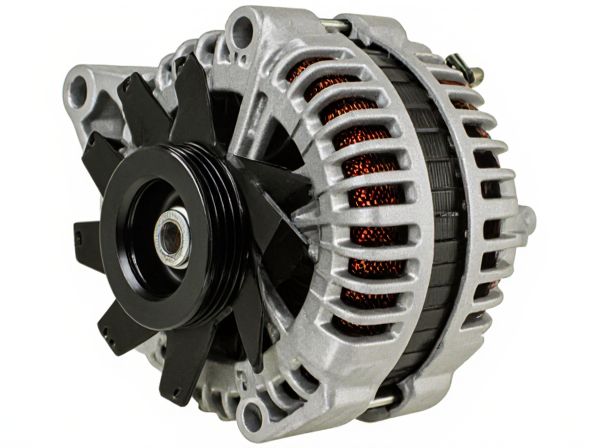
Photo illustration: Open Frame vs Sealed Frame
Open frame enclosures offer enhanced ventilation and easy access for components, making them ideal for applications requiring frequent maintenance or cooling. Sealed frame designs provide superior protection against dust, moisture, and contaminants, ensuring durability in harsh environments. Choosing the right frame depends on your specific needs for airflow, protection, and accessibility.
Table of Comparison
| Feature | Open Frame Alternator | Sealed Frame Alternator |
|---|---|---|
| Protection | Exposed internal components, less protection from debris and moisture | Fully enclosed, resists dirt, water, and contaminants |
| Cooling | Better air circulation, efficient cooling | Limited airflow, cooling via sealed design and vents |
| Durability | Less durable in harsh environments | More durable, ideal for off-road and wet conditions |
| Maintenance | Easier to inspect and repair | More complex, limited access for repairs |
| Cost | Generally lower cost | Typically higher cost due to design |
| Common Use | Standard passenger vehicles in normal conditions | Commercial, off-road, and heavy-duty vehicles |
Introduction to Frame Types
Open frame and sealed frame designs represent two primary types of motor housing used in industrial applications, each offering distinct advantages. Open frame motors allow for better air circulation and cooling, making them ideal for environments where ventilation is readily available. Sealed frame motors, on the other hand, provide enhanced protection against dust, moisture, and contaminants, ensuring reliability in harsh or dirty conditions.
What is an Open Frame?
An open frame refers to a type of electronic or mechanical enclosure that lacks solid walls or a cover, allowing easy access to its internal components for cooling, maintenance, and modification. Commonly used in industrial equipment, open frames provide superior airflow, reducing the risk of overheating in high-performance systems. This design contrasts with sealed frames by prioritizing ventilation and accessibility over environmental protection.
What is a Sealed Frame?
A sealed frame refers to a type of enclosure designed to protect electrical or electronic components from dust, moisture, and other environmental contaminants. It typically features a gasket or seal that creates an airtight barrier, enhancing durability and reliability in harsh conditions. Sealed frames are commonly used in industrial and outdoor applications where maintaining the integrity of the internal components is critical.
Key Differences Between Open and Sealed Frames
Open frames feature exposed components allowing better airflow and cooling, making them ideal for applications requiring easier maintenance and lower costs. Sealed frames encase components within a protective enclosure, providing superior resistance to dust, moisture, and contaminants, suitable for harsh or industrial environments. The key difference lies in the balance between ventilation and environmental protection, influencing durability, safety, and operational efficiency.
Advantages of Open Frame Design
Open frame designs offer superior ventilation, reducing the risk of overheating in electronic components by allowing efficient airflow. This design facilitates easy access for maintenance and modifications, enhancing serviceability and customization options. Open frame structures also typically enable lower production costs due to simpler construction and reduced material usage compared to sealed frames.
Advantages of Sealed Frame Design
Sealed frame design offers superior protection against dust, moisture, and contaminants, enhancing motor durability and reliability in harsh environments. This design reduces maintenance requirements by preventing debris ingress, extending the motor's operational lifespan. Improved insulation and vibration resistance in sealed frames contribute to better performance and safety in industrial applications.
Common Applications for Open Frames
Open frame power supplies are commonly used in industrial automation, telecommunications, and embedded systems where space-saving designs and efficient cooling are critical. These power supplies offer easy access for integration and maintenance, making them suitable for applications requiring customized mounting or frequent inspections. In contrast to sealed frames, open frames excel in environments where airflow is sufficient to dissipate heat without the need for additional enclosures.
Common Applications for Sealed Frames
Sealed frame motors are commonly used in environments where moisture, dust, and contaminants must be prevented from entering the motor housing, such as in food processing, pharmaceutical manufacturing, and outdoor equipment. These motors offer superior protection in harsh conditions, ensuring reliability and longevity when exposed to water, chemicals, or particulate matter. Typical applications include pumps, compressors, and HVAC systems that operate in wet or dirty environments requiring high durability and maintenance resistance.
Factors to Consider When Choosing Frame Type
Selecting between open frame and sealed frame enclosures requires evaluating environmental conditions, such as exposure to dust, moisture, and contaminants; sealed frames provide superior protection against harsh elements, while open frames allow for better cooling and easier access. Consider the application's airflow requirements and maintenance frequency, as open frames facilitate heat dissipation but may accumulate debris more readily compared to sealed frames. Cost implications and space constraints also affect the decision, with sealed frames often being more expensive and bulkier, whereas open frames offer cost-effective solutions for controlled environments.
Conclusion: Which Frame is Right for You?
Choosing between an Open Frame and a Sealed Frame depends on your specific application and environment. Open Frame enclosures offer better ventilation and easier access for maintenance, ideal for electronics that generate heat and require frequent adjustments. Sealed Frames provide superior protection against dust, moisture, and contaminants, making them suitable for harsh or outdoor settings where durability and environmental resistance are critical.
 caratoz.com
caratoz.com